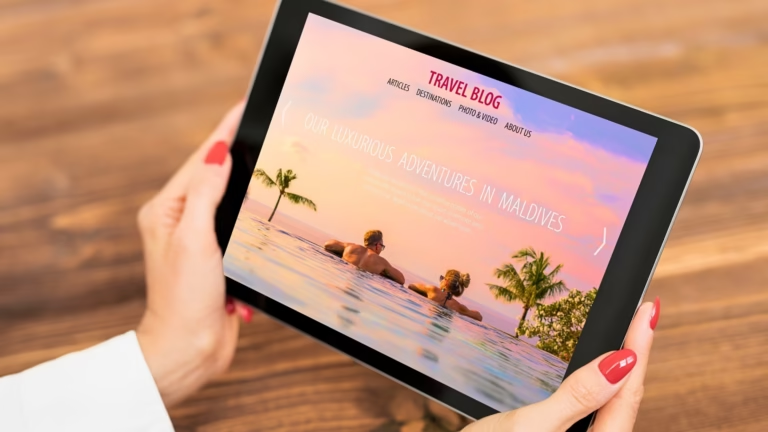Test your knowledge :)
Welcome to the internet jungle, where clicks and scrolls shape your online journey. Are you wondering how to optimize the website navigation of your blog? Imagine the joy of effortlessly finding what you need – that’s the magic of website navigation! Whether you’re a blog lover or a serious shopper, an easy-to-navigate site is your trusty guide in this digital wilderness.
Let me share a quick tale. Once, I found a blog that felt like a stroll through a well-organized bookstore. Categories were like different bookshelves, easy to browse. On the flip side, there was a corporate site that felt like a confusing maze. Click, scroll, and get a bit lost – not the best experience!
So, here’s the deal – a user-friendly site is like being a thoughtful host at a party. Let’s chat about why website navigation matters and swap stories about creating a digital space where everyone feels at home. Stay tuned!
What is Website Navigation?

Alright, gather ’round, internet explorers! Today, we’re diving into a topic that silently shapes our online adventures: website navigation. I knew nothing about blog structure when I started my first blog with book reviews. I thought I could use random settings and a random template, and all will be fine. Time showed I was mistaken. I had to learn how to navigate readers from one place in the blog to another. I tested different navigation designs. After a time, I knew what worked for my page. This is how most of the bloggers get their experience. And so did I. A lot of research, a lot of tests, and here we are. It’s like the silent hero behind the scenes, making sure we don’t get lost in the vast digital wilderness. So, what’s the deal?
Definition of Website Navigation
Imagine this: You’re in a massive digital library, and you’re on a quest to find that one specific book. Website navigation is your trusty guide, using external and internal links, menus, and a bit of online magic to help you weave through the digital shelves. It’s not just about finding info; it’s about turning your online journey into a smooth ride. It’s an essential part of every web design.
“Website navigation refers to the system of menus, links, and buttons that enables users to move around a website. It guides visitors to find information, products, or services within a website.”
web.com
Different Types of Website Navigation
Main Menu
Imagine this: the Main Menu is like the VIP spot at the top of a homepage. It’s where you find all the important links – think “Home,” “About Us,” and “Services.” It’s just like the menu at your go-to restaurant, showing you all the options to make browsing a breeze.
Think of it as entering a bustling café with menus showcasing breakfast, lunch, and dinner. Similarly, a website’s Main Menu lays out categories like “Home,” “Services,” and “Blog,” guiding visitors to different parts of the site. It’s a primary navigation element on your page.
Horizontal Navigation Bar
Now, picture a city’s main street – clear signposts guide travelers. The Horizontal Navigation Bar on a website does the same thing, guiding you through different sections while staying visible during your browsing journey.
Differences Between the Main Menu and Horizontal Navigation Bar
Main Navigation Menu: The Main Menu is like the home base of a website. It hangs out at the top or on the side and has the important stuff – think “Home,” “Services,” or “About Us.” It’s like having a map showing you the coolest spots to check out on the site.
Horizontal Navigation Menu: Imagine a line of goodies right at the top of a webpage – that’s the Horizontal Navigation Menu. It’s a neat way for the menu to show up like friends lined up together! Sometimes, it might look different, but it usually stretches across the top in a row.
So, while the main menu can look different (like the horizontal one), the horizontal navigation menu is specifically those items all lined up like a team at the top. They’re alike, but each has its own style!
Related: Learn how to start a blog.
Dropdown Navigation Menu
Another website navigation menu is a Dropdown Navigation Menu. Picture going to a food festival where stalls have tons of yummy options under different categories. Well, the Dropdown Navigation Menu is just like that! It offers lots of choices under each category when you click, making it easy to explore the site, like exploring different food stalls!
Hamburger Navigation Menu
Imagine a super sleek wallet that neatly holds all your cards – just like the Hamburger Navigation Menu. It hides links until you tap or click a small icon, saving space on the webpage. Then, like magic, it shows all the menu options!
Vertical Navigation Menu
Ever had a trusty friend on an adventure? The Vertical Navigation Menu is like that, buddy, sticking by your side on a website. It’s a sidekick guiding you through different sections without taking you away from where you are on the page. It’s all about a smooth journey through the site’s cool stuff!
Footer Menu
Scroll down, and there’s the Footer Navigation Menu, hiding at the bottom like a backstage pass! It’s got all the important info – privacy stuff, contact details, things that might come in handy someday. It’s like saying goodbye after a fun event, making sure you leave with everything you need.
Breadcrumbs
Ever heard of breadcrumbs? No, not the ones you leave in the kitchen. Online, they’re a trail leading you back through the website hierarchy. Click on any part, and boom! You’re back where you started. For example, a breadcrumb trail for a website might look like this: Home > Products > Electronics > Smartphones. Imagine it as a digital map leading you out of the maze – pretty handy, right?
Picture leaving a trail of breadcrumbs in a fairy tale forest, allowing you to retrace your path. Breadcrumbs on a website function similarly, providing a navigational trail, enabling users to backtrack effortlessly and understand their current location within the site’s hierarchy.
Sidebar Navigation
Lastly, there’s the sidebar, casually chilling on the left or right side. It’s like having that friend who knows all the shortcuts, pointing you to specific sections or categories. Perfect for sites with heaps of content. But here’s the trick – make sure it’s a friendly guide, not a confusing map that’s got you taking detours.
Think of flipping through the sections of a captivating lifestyle magazine via its sidebar. Sidebar Navigation on a website offers a complementary route, allowing users to delve deeper into specific sections without losing sight of the main content, providing a comprehensive browsing experience.
Related: Learn about Search Engine Optimization (SEO) to improve your blog’s visibility.
Now, you might wonder, why does all this matter? Why a good website navigation is so important? Well, think of it this way – website navigation is like the unsung hero of your online journey. It’s the road sign that says to website visitors, “Hey, this way to awesome content!” Each type of navigation does its own thing, but the goal is the same: making your internet adventure a whole lot easier.
So, are you ready for more navigation adventures? Buckle up because we’re just getting started on this journey through the digital wild! Stay tuned, fellow explorers!
Tips for Effective Website Navigation

Diving into the online world might feel like exploring an unknown land. But fret not, fellow digital adventurers! Learning the secrets of website navigation is an essential task. It’s like having a clear map, guaranteeing your users a smooth journey. Let’s uncover some tips to steer your digital ship and make browsing your website a piece of cake!
Keep it Simple and Intuitive
Alright, let’s talk simplicity. You must think through your website navigation design. Imagine strolling through a captivating blog or a bustling website. It should feel like a leisurely walk in the park, not an intense puzzle-solving quest. Users crave clarity, so keeping it straightforward is key. Think of clear categories and menus as friendly signposts, guiding users through your digital landscape without inducing a headache.
Now, here’s a little story to drive the point home. Once, I stumbled upon a website with a navigation menu resembling a twisted labyrinth. Every click led to confusion, and finding what I needed felt like solving a riddle. Contrast that with another site where the main menu was a beacon of simplicity – logical categories neatly arranged, and I found what I needed effortlessly. The lesson? Simple navigation is a user’s best friend.
Reduce the Number of Top-Level Navigation Links to Seven
You know that feeling when you tidy up your desk and suddenly everything makes sense? That’s what limiting top-level navigation links to seven is like for a website. It’s a total game-changer for anyone visiting your site.
By keeping it simple and sticking to seven main links, you’re making life easier for your visitors. It’s like having a clean desk – everything’s easy to find without the overwhelm.
But hey, it’s not just about tidying up. It’s about making your website look sleeker and cooler too. It adds that touch of visual appeal, making your whole design pop! Fun fact: our brains prefer dealing with around seven things at a time. So, having seven main links in your menu? It’s like giving your visitors a stress-free, well-organized space to explore. Less confusion, more focus – that’s the name of the game!
Did you know?
Optimizing Navigation for SEO: According to The Good, having fewer items in the website navigation is beneficial for search engine optimization. The home page holds the most “authority” in the eyes of Google, so it’s important to select the primary navigation links to enhance SEO carefully.
Use Clear and Descriptive Labels
Now, let’s give a shout-out to the unsung heroes of website navigation – clear labels. Picture this: you land on a site, and every link feels like a mystery novel without a synopsis. Frustrating, right? Descriptive labels for menus and categories are like the guiding voices in the background, making sure users know exactly where they’re headed. It’s all about ensuring users find what they’re after without the confusion of a labyrinth.
To illustrate, think back to the last time you were on a blog. Were the labels like a trail of breadcrumbs, leading you to intriguing content effortlessly? Or did you find yourself lost in a sea of vague categories? The takeaway here is that clear and descriptive labels transform the user experience from a scavenger hunt into a guided tour.
Ensure Easy Access to Important Pages
Alright, let’s dive into something super important: making those key pages a breeze to find. Design your website navigation with reader in mind. I mean, navigating a website shouldn’t feel like trying to crack some ancient treasure map, right? It should be more like having your friendly GPS, guiding you straight to where you wanna be in this digital universe.
Think about planning a trip. You wouldn’t want your pals struggling to find your home address or contact info, would you? Having a slick navigation system is like having this perfectly laid-out travel plan – easy peasy to follow, with all the must-visit spots clearly marked. It not only makes life simpler for users but also builds trust and reliability in your online space. ‘Cause let’s be real, who doesn’t love a smooth ride while surfing the web?
Ordering of Menu Items Strategically
Alright, let’s dish out some savvy tips on organizing your menu to catch those customers’ eyes. It’s a bit like setting up a store display to show off your best stuff and grab attention right away. A good website navigation design will help you with it.
Start by placing your must-see links right at the top of the menu. You know, like those popular or super-profitable items that people love. It’s like saying, “Hey, check these out first!” and it might just lead to more sales for those items.
Now, at the end of the menu, put those other important, high-profit goodies. That’s where customers tend to hang out, weighing their options. Placing these gems at the end might make them more likely to pick ’em.
Oh, and don’t forget to group similar items together. Like having sections for appetizers, main courses, and desserts. And within those, you can have stuff like vegetarian options or seafood dishes. It helps customers find what they want real quick.
This whole strategic lineup of menu items? It subtly guides customers to what they might love, boosting the chance they’ll pick those high-profit items and give your sales a sweet boost. It’s all about creating a menu journey that matches what customers dig and how they decide.
Did you know?
eCommerce Navigation Optimization: Dynamic Yield highlights the significance of navigation optimization for eCommerce sites. It emphasizes that the design and organization of a site can significantly impact the overall shopping experience and key metrics. Navigation optimization involves improving how visitors and search engines find and access information within a website.
Use Clear Labels for your Navigation Links
In the realm of website navigation, employing straightforward labels for your links can revolutionize the user experience. Think of them as precise signposts on a highway – guiding users directly to their desired destination, simplifying browsing effortlessly.
Clear labels act as friendly guides, swiftly directing users to their intended paths. They streamline website navigation, ensuring a hassle-free and enjoyable browsing journey. On the flip side, confusing labels? They’re like taking the wrong turn – frustrating and leaving a sour impression on users.
Opt for labels that articulate destinations explicitly. It’s all about simplifying the user experience, making it a breeze for visitors to locate what they seek, and fostering satisfaction with your site. Moreover, here’s a bonus: clear labels enhance your website’s rapport with search engines, elevating visibility and ranking.
In essence, the incorporation of crystal-clear labels in your website navigation structure is non-negotiable. It’s akin to crafting clear directions for users, elevating user satisfaction, and amplifying your website’s search engine friendliness and visibility.
Be Consistent
Let’s talk about something that’s the real MVP in website navigation – consistency. It’s like having those trusty road signs you see everywhere, making your journey smooth and easy.
Now, consistency isn’t just about looking good; it’s about keeping things steady, like having the same menu styles, button looks, and navigation bars across the board. When everything’s consistent, users get the hang of the site real quick. It’s like being on a familiar road where you know every turn.
And here’s the magic – consistency isn’t just about visuals. It’s about making things predictable and reducing the brain load for users. No one wants to get lost in a confusing maze, right?
On the flip side, if things are all over the place, users get frustrated and might just bail on your site. So, keeping that consistent vibe in website design? It’s not just a cool choice; it’s a game-changer. It keeps users engaged, happy, and more likely to do what you want them to – whether it’s buying something or signing up. For us designers and developers, sticking to this consistency rule is key. It’s the secret sauce to making sure visitors have a breezy, satisfying time exploring your site.
Add a Call-to-Action (CTA) to the Website Header
Let’s talk about spicing up your website header with a compelling call-to-action (CTA). It’s like having this eye-catching display at a store that just lures people in, making them want to explore more.
Placing a rock-solid CTA right there in the header is a clever move. It’s like having this signboard that says, “Hey, check this out!” – be it signing up for a newsletter, making a purchase, or reaching out to your business. And guess what? It can seriously bump up how many people actually do those things.
Crafting this CTA is an art – making it clear, snappy, and oh-so-enticing. You want words and designs that make visitors go, “Whoa, I gotta click that!” It’s all about getting more people to take action, whether it’s clicking, buying, or reaching out to you.
And by sticking this awesome CTA in your website header, you’re steering visitors right where you want them to go. Whether it’s getting more sales or getting more folks signed up, a killer CTA can seriously amp up your website’s game, getting people engaged and taking action.
Optimize Website Navigation for Mobile Devices
In a world where mobile devices rule the realm of website traffic, catering to mobile users becomes paramount for businesses. It’s like adapting a cozy cafe for a smaller gathering – ensuring a seamless and intuitive experience on a smaller screen is crucial.
Central to this optimization is crafting a user-friendly experience that simplifies finding information. Streamlining the menu for touch or swipe accessibility is key. Implementing a hamburger menu or a sticky navigation bar ensures effortless navigation across different website sections on mobile devices.
Moreover, space has become a premium on mobile screens. Prioritizing essential content and calls to action becomes imperative. Mobile-friendly design isn’t just an option; it’s a necessity. Businesses embracing responsive design and mobile-friendly navigation offer a positive experience to all users, irrespective of their device.
In essence, prioritizing mobile-friendly navigation is a recipe for increased engagement, improved conversion rates, and enhanced overall website performance. It’s about adapting and thriving in a mobile-centric digital landscape.
Did you know?
User Attention on Navigation Menu: Research shows that, on average, website users spend about 6.44 seconds looking at the main navigation menu on a site. This highlights the importance of having a clear and easily accessible navigation menu for a positive user experience. A well-designed navigation menu can help users quickly find what they are looking for, improving the overall efficiency of the site.
Test and Optimize for Different Devices
In today’s digital world, everyone’s got their own gadget – laptops, tablets, phones – you name it. So, here’s the thing: your website needs to be comfy for all these gadgets. That’s where responsive design swoops in like a superhero, making sure your stuff looks awesome, no matter how someone’s browsing.
Let me paint a picture. Imagine checking out a blog on your phone, and suddenly, everything gets teeny-tiny, and the buttons are like trying to catch a slippery fish. Not cool, right? That’s why testing and tweaking your website for different devices is like tailoring a suit – making sure it fits just right. You want folks to have a blast, no matter what gadget they’re using.
Bottom line? A website that’s easy to use is a real game-changer. Keep things simple, use labels that make sense, and make sure everything works smoothly, no matter if they’re on a computer or a phone. It’s not just about offering a service – it’s about inviting people on an awesome online journey. So, set sail, captain! Let your users navigate your digital world with a smile!
Importance of Blog Navigation

Let’s talk about why navigating a blog is a big deal. It’s like having a map in a theme park – helping folks find all the cool stuff without getting lost.
See, blog navigation isn’t just about finding info. It’s about making it super easy for readers to explore and stick around. When your navigation menu is neat and tidy, it’s like rolling out the red carpet for your visitors. It keeps them clicking and reading for longer, which is a win-win!
Plus, here’s a cool tip: a good navigation setup isn’t just about pleasing readers – it’s a thumbs-up for search engines too. It makes their job easier, kinda like putting signposts that say, “Hey, Google, check this out!” That means more eyeballs on your blog and more love from those search engine bots.
Now, what exactly is blog navigation? It’s the whole shebang – the menus, links, and tools that help visitors move around your blog. You’ve got the menu bar up top with dropdowns for different topics and subtopics. And hey, there’s often a sidebar with links to recent or popular posts, maybe even a search bar or a tag cloud.
The key? Make it super easy to wander around. Think user-friendly and intuitive -nobody wants to feel like they’re lost in a maze. Oh, and don’t forget about mobile users! Lots of folks are cruising through blogs on their phones, so it’s gotta be smooth sailing for them too.
So, by setting up clear and simple navigation, bloggers make sure everyone – no matter how they visit – has a blast exploring their blog. And you know what? Good navigation isn’t just about today; it keeps people coming back for more in the future. Cool, huh?
Related: Learn how to improve blog post readability.
How Blog Navigation Differs from Website Navigation
Blog navigation differs from website navigation in a few key ways.
First, blog navigation is often more timeline-focused, with a focus on presenting content in chronological order, such as by date or by category. This is because blogs are typically centered around regularly posted, time-relevant content, such as news, personal updates, or opinion pieces.
On the other hand, website navigation is often more static, with a focus on presenting a variety of information about a company, organization, or individual. Website navigation typically includes static pages such as “About Us,” “Services,” and “Contact,” which are designed to provide general information to the user.
Additionally, blog navigation often includes features such as tags and archives, which allow users to easily navigate and find specific blog posts based on topics or dates.
In contrast, website navigation tends to emphasize clear pathways to specific information or actions, such as shopping for products, signing up for a newsletter, or contacting the company.
Overall, blog navigation is more focused on organizing and presenting timely content, while site navigation is more focused on providing structured access to information about a particular entity.
Best Practices for Website Navigation

Let’s dive deep into the heart of the digital realm and unravel the secrets of blog navigation. It’s like the hidden path that, when done right, leads your readers to an enriching online experience. Ready for a journey into the intricacies of making your blog a user-friendly haven? Let’s roll!
Search Bar – The Sherlock of Your Site
Have you ever felt lost in the vast expanse of a website? That’s where the search bar swoops in like a caped crusader, ready to rescue your users from the abyss of confusion. No more endless clicking and wandering through the digital wilderness! Just type in what you’re after, hit enter, and voila – the magic unfolds.
Let me spin you a little yarn. One day, I found myself on a blog, fervently searching for a specific recipe. The search bar, my trusty companion, was strategically placed like a beacon of hope. I typed in “chocolate chip cookies,” hit enter, and there it was – my culinary Holy Grail. That’s the power of a well-placed search bar, turning a potential frustration into a victorious “Eureka!” Moment.
Now, let’s dive into the complexity of it all. Imagine a website without a search bar – a labyrinth where users are left to fend for themselves. The entropy level skyrockets as visitors navigate through various menus, hoping to stumble upon what they seek. The predictability? Well, it’s pretty much a guessing game. But introduce that search bar, and suddenly, order emerges from chaos. Users become navigators of their destiny, swiftly accessing the specific content they desire.
Categories and Tags – The Dewey Decimal System for Blogs
Picture this: You’re wandering through a vast library where every book is neatly categorized. Categories and tags are the Dewey Decimal System for your blog, providing a roadmap for readers to navigate your literary landscape. Categories serve as the broad genres, offering a general direction, while tags are the detailed labels, pinpointing the exact location of your content treasures.
Once, I found myself on a travel blog, yearning for tips on European adventures. A quick click on the “Europe” tag, and like magic, I was transported to a realm of Euro-wonders. Categories and tags, my friends, are your content Sherpas, guiding readers to their desired destination with an air of predictability and a sprinkle of burstiness as they uncover unexpected gems within each tag.
Did you know?
Phased Approach and Tools for Optimization: Search Engine Journal suggests using a phased approach for optimizing large websites and leveraging automation tools to identify and fix navigation issues. It’s essential to ensure that everyone involved in maintaining different website sections follows the same SEO principles and practices.
Related Posts – Your Virtual Tour Guide Through the Content Jungle
Have you ever finished reading an article and wondered, “What’s next?” Related posts are like your personal tour guide through this content jungle. They’re the digital version of a friend saying, “Hey, check this out!”
Let me tell you a story. Once, I stumbled upon this blog about DIY home decor. At the end of every post, there they were – related projects calling out to my creative side. One click led to another, and bam! I was knee-deep in a weekend DIY extravaganza. That’s the magic of related posts – keeping you hooked, adding excitement to your journey, and unveiling more cool stuff.
Now, let’s break it down. Related posts are like threads weaving through your blog, guiding readers to content they’ll love. They make the journey surprising and fun – jumping from one post to another, deepening their interest and hanging out on your site for longer. Plus, it’s a win-win: your SEO gets a boost from this extra exploration, and readers get to see more of your content palette. Pretty neat, right?
Call-to-Action – Your Blog’s Personal Cheerleader
Now, let’s talk about the grand finale – the call-to-action (CTA). Imagine reading a fantastic blog post and then… silence. A well-crafted CTA is like a friendly cheerleader, urging your readers to take the plunge. Whether it’s signing up, commenting, or exploring more, a good CTA guides your audience to the next thrilling chapter of their interaction with your brand.
Let me weave another tale. I was engrossed in a blog about sustainable living, soaking in every word of wisdom. As I reached the end, there it was – a CTA urging me to join their eco-friendly community. The result? I became part of a movement, my engagement transitioning from passive reading to active participation. That’s the magic of a compelling call-to-action – turning moments of inspiration into actionable steps, bridging the gap between content consumption and audience interaction.
Now, let’s peel back the layers. A well-crafted CTA is not just a button at the end of a post; it’s a strategic guidepost, steering your readers toward meaningful engagement. It introduces an element of predictability, offering a clear direction on what steps your audience can take next. Simultaneously, it injects a burst of energy into your blog’s narrative, prompting readers to become active participants rather than passive observers.
Consistency Across Pages – The Glue Holding Your Navigation Together
We’ve strolled through the wonders of search bars, danced with categories and tags, and felt the pulse of related posts and CTAs. Now, let’s talk about the glue that holds it all together – consistency across pages. It’s the silent architect ensuring your user’s journey is seamless, predictable, and bursting with engaging possibilities.
Imagine this: You enter a beautifully designed website, captivated by its intuitive navigation. You click from the homepage to a blog post, and suddenly, everything changes – the menu is different, and the layout feels foreign. The perplexity sets in, disrupting the user’s experience. Now, flip the script. Consistency across pages is like a familiar melody playing throughout your site. The predictability of finding the menu in the same spot encountering a similar layout – it’s the comfort food of the digital world.
In my own web explorations, I’ve encountered sites that nailed consistency. From the homepage to the deepest corners of the blog archives, the design language flowed like a well-composed symphony. It wasn’t just a navigation; it was an immersive experience that kept me grounded in the site’s aesthetic, fostering a sense of trust and familiarity.
Now, let’s delve into the intricacies. Consistency doesn’t just happen; it’s a deliberate choice in design and structure. It’s about maintaining a similar look and feel across various pages, ensuring your users aren’t thrown off by unexpected changes. This predictability creates a user experience that feels cohesive and reliable, reducing perplexity and enhancing the overall journey.
Navigational Alchemy for Your Blog
Let’s dive into making your blog a total breeze to use. Think of it like drawing a treasure map, but instead of gold, it leads to all the cool stuff on your blog – pretty neat, huh?
You’ve got these cool tools—search bars, categories, and tags. They’re like friendly guides, showing your visitors where the good stuff is. And those related posts? They’re like hidden paths to even more exciting adventures!
Imagine your blog as a fun party for your friends. You want it to be easy and fun, right? Each tool is like a special guide, helping everyone explore and discover all the awesome things on your blog.
So, let’s turn your blog into a place where every click is an adventure! Get ready for loads of fun and discovery in your fantastic digital world!
Related: Learn how visual content can improve your blog.
Common Mistakes to Avoid in Website and Blog Navigation

Alright, folks, let’s talk about something crucial – avoiding those website and blog navigation pitfalls that can turn your visitors into frustrated internet wanderers. Picture this: you’re in a new city, and the GPS on your phone is acting up. Annoying, right? Well, the online world is no different. So, let’s dodge the digital potholes and ensure your users have a smooth ride.
Cluttered and Confusing Menus
Have you ever been to a restaurant with a menu so vast it feels like you’re deciphering a secret code? Cluttered and confusing menus on a website can create that same head-spinning experience. Too many options and subcategories are flying left and right – it’s a recipe for confusion.
I remember stumbling upon a blog where the menu felt like an elaborate puzzle. I was hunting for a specific article, but the plethora of choices left me scratching my head. In the end, I gave up. That’s the danger of a chaotic menu; it’s like trying to find a needle in a haystack. It’s not just about what’s on the menu; it’s about making sure users can easily pick their dish.
Now, let’s demystify the chaos. Imagine your website’s menu as a roadmap, guiding users to their desired destination without sending them on a wild goose chase. Streamlining menus, simplifying options, and organizing with user feedback in mind can turn that confusing maze into a clear path, making the user’s journey more of a pleasant stroll than a frustrating labyrinth.
Lack of Search Functionality
Have you ever visited a website and found yourself on a scavenger hunt for the search bar? It’s like looking for your keys when you’re late – stressful and time-consuming. The lack of a search bar can be a real game-changer in a user’s experience.
Let me share a personal tech hiccup. Once, I stumbled upon a website without a search bar. I needed info buried deep within the pages. Without that search lifeline, it felt like diving into an ocean without a compass. I nearly gave up, but the stubborn side of me prevailed. Needless to say, it wasn’t a walk in the park.
Here’s the deal – users expect a search bar to be their trusty sidekick in the quest for information. When it’s missing, frustration sets in. Incorporating a search bar is like handing your users a flashlight in the dark corners of your website. It’s about giving them the power to navigate swiftly and find what they’re after without the hassle.
Inconsistent Navigation Across Different Pages
Now, imagine this: You’re reading a book, and suddenly, the font changes with every page. Disorienting, right? Inconsistent navigation across different website pages can create that same feeling. It’s like trying to follow a map where the landmarks keep shifting places.
I once explored a website where the navigation bar played hide and seek. On the homepage, it was a smooth ride. But as I delved deeper into product pages, it was like stepping into a parallel universe. The categories were different, and finding my way back became a puzzle. That’s the danger of inconsistent navigation – users might feel like they’ve entered the Twilight Zone.
Consistency is the secret sauce. It’s about maintaining the same melody across your website, ensuring users don’t feel like they’ve taken a detour into confusion. When navigating from the homepage to product pages, users shouldn’t feel like they’ve entered a different dimension. Implementing a standardized navigation system is like providing a clear path through the digital forest, ensuring users don’t get lost in the tangled branches.
In a nutshell, avoiding these common navigation pitfalls is like ensuring your online guests have a smooth, frustration-free journey. It’s about turning potential chaos into a well-orchestrated symphony, where menus are clear, search bars are at their fingertips, and the path remains steady and predictable. Happy navigating, fellow digital trailblazers!
Conclusion

Alright, let’s put a bow on this navigation talk. A good understanding of what website navigation is essential. Unfortunately, many website owners underestimate it. Easy peasy navigation is like having a friendly guide through the online jungle. You don’t want your users feeling like they’re in a maze, right? A smooth ride through your website not only keeps them happy but also shouts, “Hey, we know what we’re doing here!”
Now, here’s a little story. I once stumbled onto this website that felt like a treasure hunt. The navigation was like a secret code, and I was on a mission to crack it. Spoiler alert: I didn’t find the hidden treasure. Lesson learned – a site’s navigation is like a first impression; make it count.
So, why fuss over this? Because a simple, clear, and efficient navigation system isn’t just good for users; it’s a badge of professionalism for your website. It’s like saying, “We got this, folks!” And guess what? You can’t just set it and forget it. It’s an ongoing journey. Keep an eye on user vibes, ask for their two cents, and tweak things to keep that online adventure smooth and delightful. Happy navigating!
FAQ
How do I optimize my website navigation?
Improving website navigation is all about making things easy for visitors. Use clear menus and dropdowns, and make sure searching is a breeze. Blogs should have simple navigation with categories, tags, and related posts easy to find. Oh, and make sure it works well on mobiles and consider adding breadcrumbs. That way, everyone can move around your site without any trouble!
How do I make a good navigation for my website?
Building a great website navigation is like crafting a roadmap for your visitors. Organize content into logical categories and use clear labels for menus. Make sure visitors can easily access them from any page. Adding visual elements like dropdown menus or a search bar can level up the convenience factor.
How do you measure website navigation success?
Evaluating website navigation success involves looking at metrics. These are bounce rate, time spent on the site, and pages visited. Feedback from users and usability tests also give helpful insights. In the end, it’s all about how easily users find the info they want.
What is the most common website navigation techniques?
When it comes to navigating websites, you’ll often see a top bar with dropdowns, a handy sidebar, and that cute little hamburger menu for mobiles. Oh, and don’t forget those breadcrumbs, search bars, and footer links. They’re all part of making things super easy for you to find what you’re looking for on a website. Easy, right?
What is navigation optimization?
Optimizing navigation is like tidying up a messy room to make it easy for guests to find things. You’re fixing menus, search bars, and links so folks can easily get what they want. When things are smooth, everyone’s happier exploring around!
Book Your Trip with These Resources
Here are my go-to resources for planning a seamless and stress-free trip. I personally use these services and highly recommend them.
Flights and Transportation
- Skyscanner – Best for finding cheap flights worldwide.
- Kayak – Ideal for comparing multiple travel sites at once.
- Rome2Rio – A fantastic tool for planning multi-modal transportation routes.
Accommodation
- Booking.com – Best rates for hotels and guesthouses.
- Agoda – Best rates for hotels.
- Hostelworld – Perfect for budget travelers and solo adventurers.
- Airbnb – Great for unique stays and long-term rentals.
- HotelTonight – Awesome for last-minute hotel deals.
Travel Insurance
- SafetyWing – Comprehensive coverage for all travelers.
Trip Planning and Activities
- Get Your Guide – Find tours, skip-the-line tickets, and local experiences.
- Klook – Book tours, tickets, and activities at your destination.
Helpful Tools
- Google Translate – Break language barriers while traveling.
- SurfShark VPN – Stay safely connected wherever you go.
Don’t Forget to Read
Affiliate Disclosure: Some links above are affiliate links, meaning I earn a small commission if you purchase through them at no extra cost to you. These help me keep the blog running, so thank you for your support!











